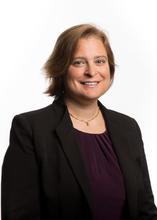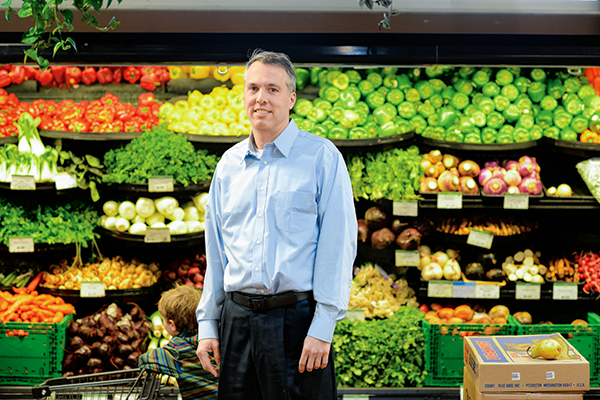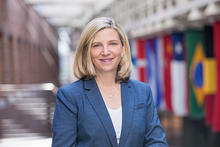
Scholarly Interactions
Saturday, September 1, 2018
By Kevin Moe
Pinar Karaca-Mandic, associate professor of finance at the Carlson School and the academic director of the Medical Industry Leadership Institute, is also a core faculty member of the Institute for Health Informatics at the U’s Academic Health Center.
The institute’s primary work involves designing and evaluating information systems to support and improve healthcare. Its faculty run the gamut from nursing and medicine to computer science. Information and decision sciences is also represented, as Carlson School Professors Shawn Curley and Paul Johnson are also members.
“Healthcare itself sits at the intersection of very different disciplines,” Karaca-Mandic explains. “My background is in economics. I can look at it like that, but it’s not going to be the same as a clinician looks at it or a data scientist or someone from public health. It’s really important for me to become connected to not miss out on these other insights. It gives me exposure to some of the things that are going on in the academic world.”
A Community of Scholars
Karaca-Mandic has to travel to the East Bank to get to the Institute for Health Informatics, but the University’s Department of Economics is more closely connected to the Carlson School—by a skyway as a matter of fact.
A number of Carlson School faculty, such as Karaca-Mandic, Hengjie Ai, Maria Ana Vitorino, Aaron Sojourner, Song Yao, Joel Waldfogel, and others, often cross this skyway for meaningful scholarly interaction with members of the Economics Department, which is on the fourth floor of Hanson Hall.
“I think that the nearby presence of the Carlson School makes the Economics Department a more attractive and productive place, and, of course, vice versa,” Waldfogel says. “Minnesota does well in worldwide rankings of business and economics because there are top-notch scholars on both sides of the skyway. And the cross-fertilization of the communities is an important part of the story.”
Waldfogel, the Frederick R. Kappel Chair in Applied Economics in the Department of Strategic Management and Entrepreneurship, has two affiliated appointments at the U, one in economics and one at the Law School.
“I am an economist, and much of my research is divided between industrial organization—a branch of economics that is close to strategic management—and law and economics,” he says. “Methodologically, my research falls squarely within economics, so the fit with the Economics Department is quite natural.”
His role in the Economics Department is to advise PhD students, which in many cases turn into colleagues and coauthors. He also teaches a PhD course that attracts enrollment from both the Carlson School, from a variety of departments, and Economics Department students interested in applied microeconomics in general and industrial organization in particular.
“The benefit of my relationship with the Economics Department is an enormous complement to my strong relationships with Carlson faculty,” he says. “With Carlson faculty, I share an interest in a common set of questions. My economics colleagues, and the PhD students, give me a community of scholars who share approaches to answering those questions.”
Broadens and Enriches Understanding
Like Waldfogel, Work and Organizations Professor Avner Ben-Ner spends some of his time at the Law School. As an adjunct professor there, he has lately been collaborating with a colleague, Professor Claire Hill, on their common interest in questions related to identity and ethnic, cultural, and other forms of diversity.
“Professor Hill has been working on legal angles, and I have researched organizational interactions,” he says. “We combined our specialized skills and started studying how to use law and public policies to ameliorate some of the undesirable effects of diversity and to enhance the beneficial ones.”
Hill says that law and business both need an understanding of personal and group dynamics as they affect what people do as well as how they perceive the world.
Currently, Ben-Ner and Hill are writing a paper for a law journal concerning the legal treatment of nonprofit organizations.
Through his collaboration, Ben-Ner has become involved in some activities at the Law School and has presented at conferences on corporate governance, how to increase trust in society, and more. “Through these interactions, I learn to look at various issues of research and teaching interests to me from additional perspectives, to which I am not exposed in my regular interactions with colleagues at the Carlson School,” he says. “I present in Law School classes and my law colleagues present in my classes.”
Ben-Ner adds that attending seminars and conferences at the Law School exposes him to other ways of thinking and broadens and enriches his understanding of business phenomena. “This influences my research and teaching,” he says. “Academics are specialized in narrow fields, but many questions cannot be answered from a narrow perspective. So, cross-disciplinary interactions benefit our research.”
Since the legal profession is at the intersection of many fields and disciplines, such as politics, economics, and history, the Law School encourages involvement by faculty members from other parts of the University.
“We tell our students that their clients will not present them with ‘a tort problem’ or ‘a contract problem,’—they will present them with ‘a problem,’” says Hill. “The same is true of the broader academic endeavor. We are all trying to understand what makes the world tick, and how it can work better. That requires skills from many disciplines.”
Collaboration Makes a Healthy Diet
Marketing Professor Joseph Redden has been combining his skills with colleagues’ across the University on a series of projects that explore how to encourage elementary school children to eat more vegetables. “We’ve been doing this research in willing elementary school cafeterias to really test our ideas,” says Redden, who holds the Board of Overseers Professorship in Marketing. “That is, can you actually get the child to ultimately eat more vegetables?”
Redden has been working with Professors Zata Vickers and Marla Reicks from the Department of Food Science and Nutrition, Professor Traci Mann of the Psychology Department, and Associate Professor Elton Mykerezi from the Department of Applied Economics.
The relationships with these various professors originated from a mixture of ways. For Vickers, Redden went to a presentation she gave on liking and satiety. “After the talk, we were discussing some of our overlapping research interests,” he says. “A few days later, she saw a posting NASA had for some food satiety studies, and we’ve been off working together since then.”
As for Mann, Redden knew that she was doing a lot of work on dieting and healthier eating, so he and Vickers contacted her to see if she was interested in joining the group. “For Marla Reicks, I first got involved with her after I served on a committee for a master’s student in the Food Science and Nutrition Department,” Redden says. “So, as you can see, there is no one way. Our connections just seem to keep growing in this organic way.”
For its research into healthy consumption among schoolchildren, the group has found several successful strategies. “One of the most robust is serving vegetables first in isolation, either in a cup handed to them while they wait in line or waiting for them at their table,” Redden says.
There are several reasons why this strategy works: children are most hungry before their meal, people have a natural tendency to eat a food when it is placed in front of them, vegetables look unattractive when placed next to a tasty entrée on a plate, and there is a social norm to accept the “gift” of a vegetable beforehand, among others.
Although Redden and his fellow researchers all share a common interest in doing high quality, impactful work, what is great about this collaboration is that each person brings something unique to help that goal. “Zata really drove our relationship with the school cafeterias and did a great job developing a research mindset and flexibility with the school personnel,” Redden says. “Traci has a great ability to identify interesting questions and then design simple, elegant ways to test and discuss them. And Elton has a great skill set for analyzing data, which has been useful in dealing with some of the tricky aspects of field data.”
And Redden’s contribution? “As a consumer researcher in marketing, I am often thinking about how do we help customers see the value of what is offered,” he says. “This includes how we communicate our messages to persuade people. So, one of my contributions has been bringing some of these consumer frameworks to our projects, especially in the areas of judgment and decision making.”
Redden says that this cross-campus collaboration has been so valuable, that it is safe to say these projects wouldn’t have been completed without each person doing his or her part. “The great value in my case was also that we all shared this common goal of healthier eating in schools, yet we each were coming at it from a different theoretical angle,” he says.
At Your Service
There’s more to being a faculty member than teaching and research. In Marketing Professor and Carlson Foundation Chair Vlad Griskevicius’ case, it also entails membership on various University-wide committees.
“These types of committees exemplify ‘thankless’ work that’s done by faculty at the University,” he says. “There is no compensation for these kinds of committees and there is no prestige associated with doing this kind of work. Faculty serve on these kinds of committees because they are important in keeping a world-class university running—and for keeping the University of Minnesota a world-class university.”
Griskevicius currently serves on three committees: the Provost’s Grand Challenges Committee, the McKnight Land-Grant Professorship Committee, and the Liberal Education Redesign Committee.
The Grand Challenges Committee consists of about 20 University faculty from a wide array of disciplines. The purpose of the committee is to review collaborative research proposals and determine which ones merit funding. Each year, this process takes about 20 hours of individual pre-work and another 10 hours of group discussion.
“The committee is important because it helps allocate scarce resources to the most deserving parties,” Griskevicius says. “It is important that the committee represents diverse and varied perspectives, including the Carlson School. This ensures fairness in the process of selecting the most deserving proposals.”
The McKnight Land-Grant Committee was established to help retain the best young faculty at the U. “The goal of the program is to retain the best minds in the world and compel them to stay in Minnesota, instead of leaving for places like Harvard or Stanford,” Griskevicius says.
Each year, every department at the U can nominate one young faculty member for the McKnight Land-Grant Professorship. It is a highly prestigious professorship that is worth around $100,000 in research money to the faculty member and comes with a prestigious title.
The committee consists of about 15 faculty, many of whom were past recipients of the professorship. “The job of the committee is to review all of the nomination packets and select the most deserving candidates,” Griskevicius says.
He says it is essential that Carlson School faculty be on this committee to ensure fairness and diversity as well as help young faculty at Carlson compete for this prestigious professorship.
The Liberal Education Redesign Committee is looking at the general education requirements that must be completed by all undergraduate students.
The committee consists of 20 faculty from all parts of the University. There are many different opinions and perspectives on the matter of liberal education and the topic is both ideological and political. “It is extremely challenging for a group of 20 faculty to agree on one plan for a huge university like the U of M,” Griskevicius says.
Like Griskevicius, Strategic Management and Entrepreneurship Professor Mary Benner is a member of the redesign committee.
Benner also sits on the Research Committee of the Provost’s Council on Student Mental Health. The committee is undertaking research into how instructors can design courses to avoid creating unnecessary and unintended challenges for students’ mental health. “Again, this is part of using the rich knowledge and experience we have around the University to improve the solutions and educational experiences for all students,” she says.
Benner says that in addition to the value these committees have in addressing University-wide issues, they also draw faculty out of their narrower, relatively specialized worlds to engage with colleagues in different schools. “I think these cross-college and cross-departmental connections help us understand differences in ways of thinking, and also how to communicate and find common ground,” she says. “We are all committed to educating our students, and working together makes the U a stronger place.”
As experts in international education, Associate Dean of Global Initiatives Michael Houston and Assistant Dean of Global Initiatives Anne D’Angelo work across campus with various organizations devoted to global issues. They are both members of the International Programs Council, which is charged with shaping the policies and processes that affect global programs and activities throughout the University. The council is made up of representatives of nearly every collegiate unit and is organized by the Global Programs and Strategy (GPS) Alliance, the central international office for the entire University system.
“It is rewarding to work closely with colleagues committed to internationalization across campus and system-wide,” D’Angelo says. “We learn from each other, engage in cross-college and campus issues and initiatives, and enhance policy and practice in support of our students, faculty, staff, and partners here and around the world.”
Houston, the Ecolab-Pierson M. Grieve Chair in International Marketing, also is a member of the China Center Advisory Council, which seeks to build bridges among the U’s China Center and academic units throughout campus as well as strengthening connections between the University and the community. Located on the East Bank, the China Center has supported international research, outreach, and teaching for nearly 40 years.
In a similar capacity, Houston is on the board of the Center for Austrian Studies (CAS) in the Social Sciences Building on the West Bank. CAS is the oldest research center in the Western Hemisphere that focuses on the past, present, and future of Austria.
“With our deep relationship with the Vienna University of Economics and Business and our multiple partnerships in China, involvement with the China Center and the Center for Austrian Studies is valuable in that it keeps us tuned in to the activities related to Austria and China of other university units on campus,” Houston says. “We are also able to keep these centers informed about our activities. The result is mutual benefits to all involved.”
From 2010-15, D’Angelo served on the inaugural U of M metrics committee on internationalization, a task force established by the Associate Vice President and Dean of GPS Alliance, Meredith McQuaid, to create the first metrics model for internationalization used by colleagues across the U of M system.
“The collaboration of colleagues from the Provost’s Office, GPS Alliance, the Carlson School, and other colleges and campuses across the University of Minnesota resulted in an innovative and comprehensive model that serves as a tool to capture key data associated with efforts to globalize the U of M’s teaching, learning, research, and engagement,” she says. “The Carlson School is the first college to implement a metrics process based upon the University model.”





